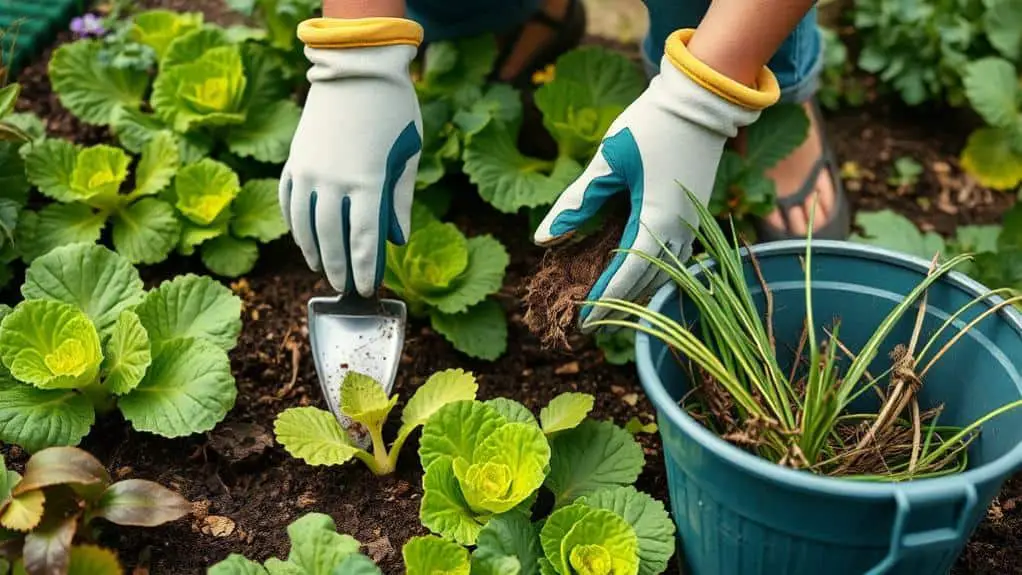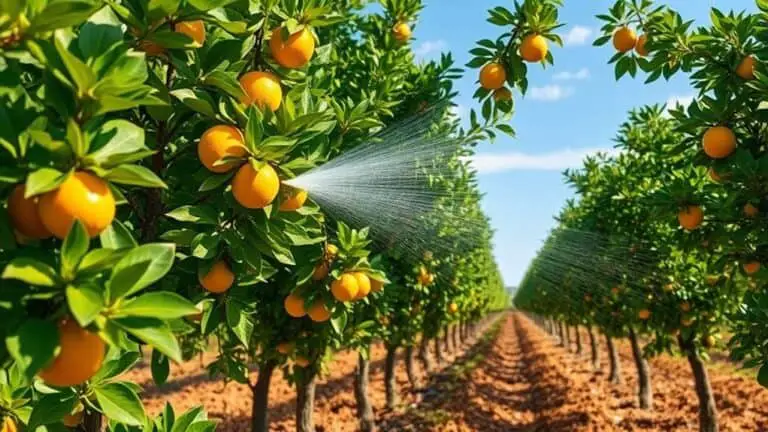How To Get Rid Of Prickly Lettuce Weeds
I've noticed that prickly lettuce can be quite a nuisance in the garden, with its tall stature and spiny leaves making it difficult to manage. If you're like me, you're probably wondering about the most effective ways to tackle this invasive weed. From manual removal techniques to the strategic use of herbicides, there are several methods to reflect upon. But before we get into those, let's first talk about how to accurately identify prickly lettuce and understand the challenges it poses. This initial step is essential and will set the stage for successfully dealing with it.
Identifying Prickly Lettuce
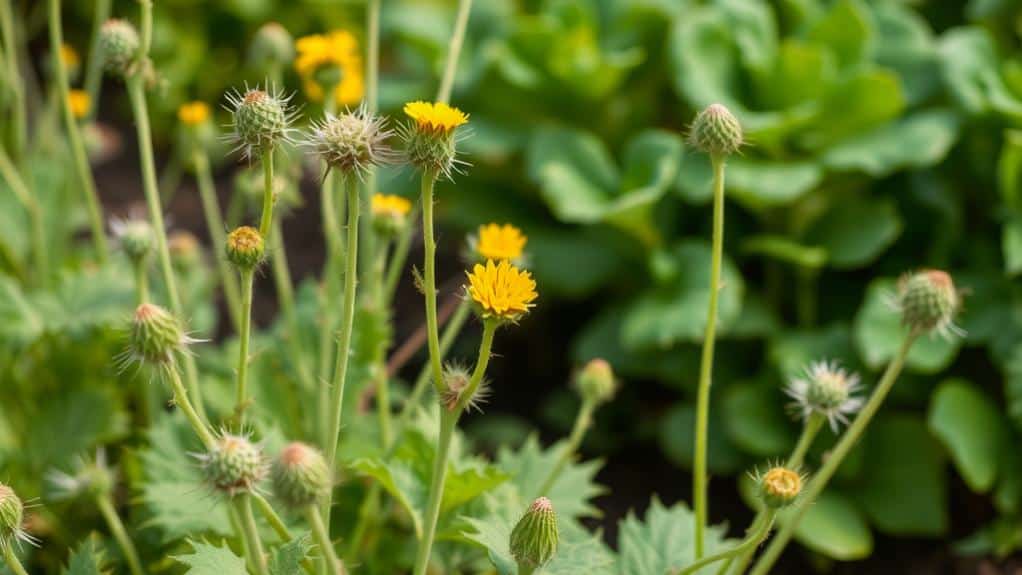
When you're trying to tackle prickly lettuce in your garden, the first step is proper identification.
Prickly lettuce, also known as Lactuca serriola, stands out with its tall growth, reaching up to five feet. Its leaves are deeply notched and have spiny edges, making them easy to spot. One unique feature is the milky sap it exudes when you break a leaf. This sap can clog equipment and harm livestock, so it's essential to identify it correctly.
Look for yellow flowers blooming from late spring to early summer. The leaves also align vertically, like a compass, differentiating it from dandelions. Spotting these traits helps you manage this invasive plant effectively.
Understanding the Challenges
Understanding the challenges of managing prickly lettuce is essential for effective control. This weed is tough to handle due to several factors. Its deep tap root makes it difficult to control completely, as any roots left behind can cause regrowth. The plant's milky sap can clog gardening tools, complicating removal. Additionally, waiting until it flowers can lead to rapid seed dispersal, with a single plant producing thousands of seeds. These seeds are highly adaptable, germinating quickly and remaining viable for years. Given its invasive nature and fast spread, tackling prickly lettuce requires a strategic approach.
| Challenge | Impact | Solution |
|---|---|---|
| Deep Tap Root | Difficult to control | Guarantee complete removal |
| Milky Sap | Clogs tools | Clean tools regularly |
| Rapid Seed Dispersal | Thousands of seeds spread | Remove before flowering |
| Seed Viability | Persistent regrowth | Monitor for new seedlings |
| Invasive Nature | Spreads quickly | Implement ongoing management |
Manual Removal Techniques

Tackling prickly lettuce requires a hands-on approach to complement our strategy against its invasive nature.
To effectively remove these weeds, it's best to pull out young plants just after they've germinated or before they flower. This helps prevent them from spreading seeds.
Make sure the ground is moist when you do this; it makes it easier to pull out the entire taproot. If you don't get the complete extraction, dig deeper until the whole root is removed to stop regrowth.
Once pulled, let the plants dry in the sun to eliminate the milky sap, which can clog tools.
Remember to compost mature seeds separately to avoid future infestations.
Happy weeding!
Benefits of Lawn Aeration
Lawn aeration is a fantastic way to strengthen your grass roots, making them more resilient against weeds like prickly lettuce.
By creating small holes in the soil, aeration allows air, water, and nutrients to reach the grassroots more effectively.
Plus, it helps reduce soil compaction and improve overall soil health, giving your lawn the best chance to thrive.
Strengthen Grass Roots
Aeration's an essential step in fortifying your lawn's grass roots, making it a potent strategy against the pesky prickly lettuce weed. By creating small holes in the soil, aeration boosts moisture content and promotes stronger grass roots, leaving less room for weeds to take hold. The best times to aerate are spring and fall when the ground's moist, ensuring easy penetration and quick recovery for your lawn.
| Benefit | Description | Timing |
|---|---|---|
| Improved Roots | Stronger grass roots reduce weed growth | Spring/Fall |
| Moisture Content | Better water absorption for healthier grass | Post-Aeration |
| Weed Prevention | Dense grass outcompetes weeds like prickly lettuce | Ongoing Maintenance |
A healthier, denser lawn naturally resists invasion, making your battle against prickly lettuce easier.
Enhance Nutrient Uptake
When we aerate our lawns, we're creating small holes that greatly enhance nutrient uptake by the grass roots. This process is key for a healthy, robust lawn, especially in spring and fall when the ground is moist.
Aeration allows air, water, and nutrients to penetrate deep into the soil, alleviating compaction and promoting stronger root systems. After aerating, watering and fertilizing your lawn guarantees that these nutrients are effectively absorbed.
Improve Soil Aeration
By creating small holes in the soil, we enable air, water, and nutrients to reach deep into the root zone, promoting healthier grass growth.
This process, known as soil aeration, is highly effective in the spring and fall when the soil is moist. Aerating strengthens the grassroots, which helps reduce the likelihood of weed seed germination, including pesky prickly lettuce.
- Power or manual aerators: Choose based on your lawn size.
- Watering and fertilization: Essential steps post-aeration.
- Robust grass growth: Creates a competitive edge against weeds.
Aeration not only improves soil aeration but also guarantees your grass grows strong and lush.
With stronger grass, weeds won't stand a chance, and you'll enjoy a healthier, greener lawn.
Effective Herbicide Use
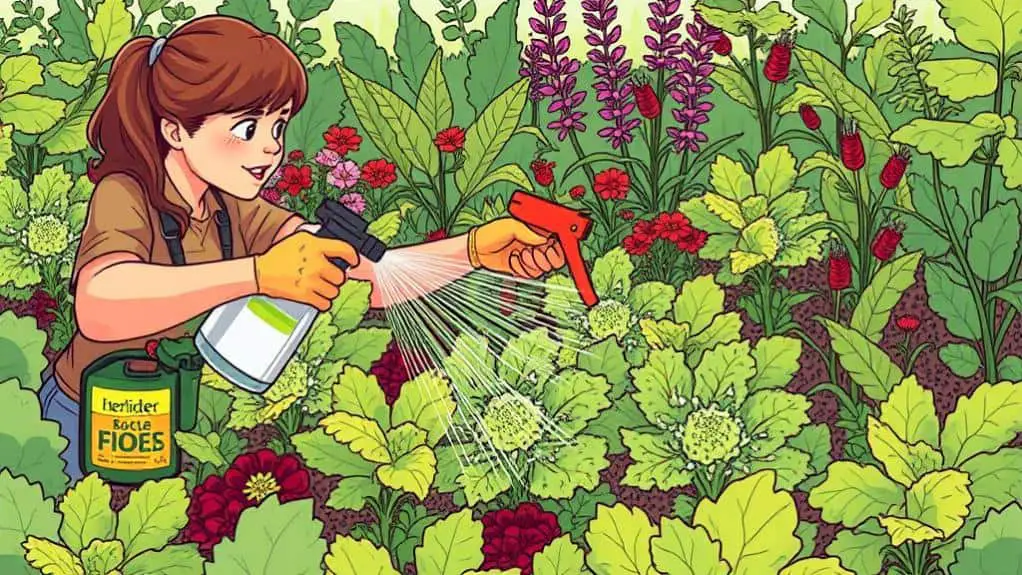
For effective control of prickly lettuce, herbicides can be a powerful tool when used correctly. Timing is everything. Applying herbicides containing glufosinate, glyphosate, or paraquat before the plants flower guarantees you catch them early, minimizing seed spread.
Pre-emergence herbicides like isoxaben and atrazine are great for preventing seeds from germinating in the first place, offering long-term control.
Don't forget about organic options! Clove oil (eugenol) can effectively manage young broadleaf weeds, including prickly lettuce.
Just remember, it's essential to monitor for herbicide resistance in some prickly lettuce populations. This helps make certain your chosen method stays effective.
With these tips, you'll be well-equipped to tackle prickly lettuce weeds in your garden.
Mowing and Raking Methods
Managing prickly lettuce weeds with mowing and raking methods can considerably reduce their spread and impact. When I mow, I need to do it before the weeds flower to prevent seed dispersal. Regularly mowing can keep the plants from blooming and minimize seed production.
After mowing, I rake up the seedlings to stop them from establishing deep roots.
- Mowing before flowering: Stops seed dispersal.
- Raking seedlings: Removes young plants early.
- Using a weed wacker: Prevents blooming.
Cutting plants below soil level is essential because it removes their energy source, preventing regrowth.
Consistent monitoring and early intervention are key to managing infestations effectively. By combining mowing and raking, I can keep my garden free of prickly lettuce weeds.
Natural Remedies and Uses
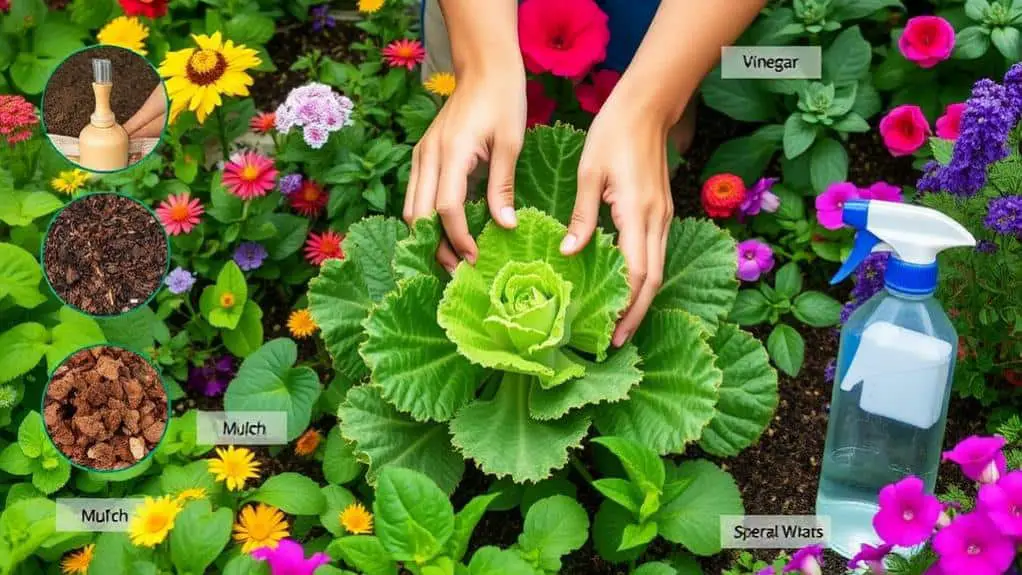
Prickly lettuce isn't just a pesky weed; it's also a treasure trove of natural remedies. This medicinal plant has been cherished for its calming effects and pain relief. You can chew the leaves to experience mild analgesic effects, a trick many have found useful.
The plant's milky sap, which appears when broken, is often used in herbal remedies for its soothing properties. Making tinctures from prickly lettuce can help with several ailments, showcasing its traditional uses.
Some gardeners even keep prickly lettuce around intentionally, valuing its health benefits. Plus, if you have chickens, they can safely graze on it, enjoying its nutritional value while helping to control the weed naturally.
Environmental Factors
While prickly lettuce has its benefits, understanding the environmental factors that contribute to its growth can help you manage it more effectively. These factors include soil acidity and nutrient availability, seasonal changes, and local environmental conditions.
- Soil Acidity and Nutrient Availability: Prickly lettuce thrives in well-drained soils with high nutrient levels, making it essential to monitor and adjust soil conditions.
- Seasonal Changes: Temperature and moisture variations influence germination, with seeds able to remain viable for several years, complicating control efforts.
- Environmental Conditions: Prickly lettuce prefers disturbed areas with ample moisture, requiring around 30+ inches of water annually for ideal growth.
Community Support and Resources
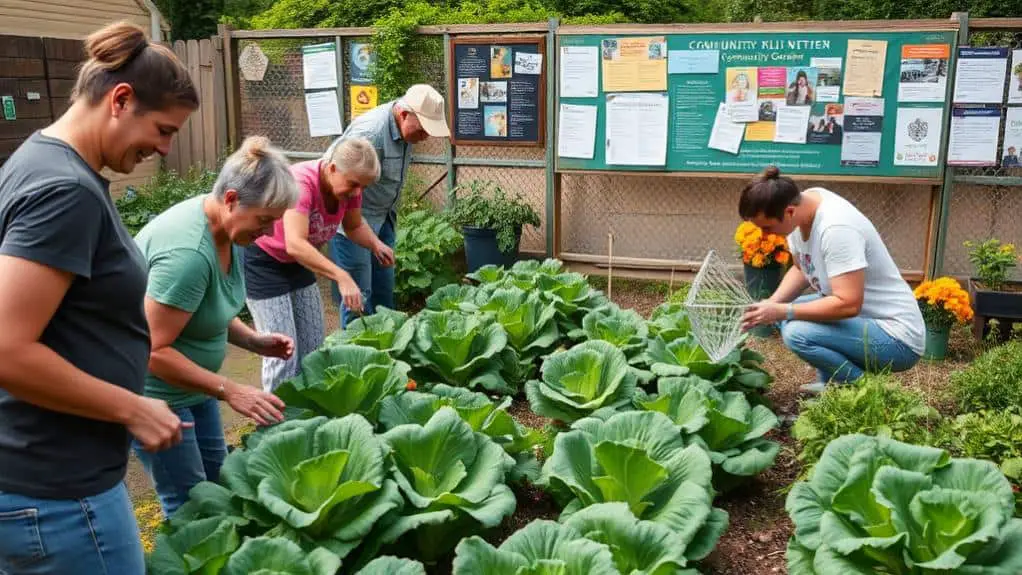
Joining community support groups and utilizing available resources can make a significant difference in managing prickly lettuce infestations. I've found that community gardening practices not only help tackle the problem collectively but also promote resource sharing. Networking with fellow gardeners provides invaluable tips on natural remedies and uses for prickly lettuce. Local extension services often hold workshops that educate us about identifying and managing this weed. Online forums and gardening communities are great platforms to share experiences and effective control methods.
Here's a quick table to summarize:
| Resource Type | Benefits | How to Access |
|---|---|---|
| Community Gardening | Collective efforts, resource sharing | Join local gardening clubs |
| Local Extension Services | Workshops, educational resources | Visit local extension office |
| Networking with Gardeners | Tips and natural remedies | Participate in forums, meetups |
Monitoring and Early Detection
Keeping an eye on your garden for the early signs of prickly lettuce can make all the difference in preventing a full-blown infestation. Regularly inspect your garden, especially in spring when seedlings are small and easier to remove.
Don't forget to monitor neighboring properties, as wind can carry seeds into your garden. Early detection is key because a single plant can produce thousands of seeds.
Look for:
- Deeply notched, spiny leaves
- Tall growth habits, up to 5 feet
- Flowering plants from late spring to early summer
Frequently Asked Questions
How Do You Prevent Prickly Lettuce?
To prevent prickly lettuce, I focus on soil management and companion planting. I also use natural herbicides. By maintaining healthy soil and planting native plants, I create an environment where prickly lettuce struggles to thrive.
How Does Prickly Lettuce Spread?
Prickly lettuce spreads through effective seed dispersal methods, like wind carrying its lightweight seeds. Favorable growth conditions, such as moist soil, boost its spread. This ecological impact leads to rapid colonization of gardens, roadsides, and fields.
Is Prickly Lettuce Invasive?
Yes, prickly lettuce is invasive. Through proper prickly lettuce identification, understanding its ecological impact, and employing effective control methods, we can manage its spread and protect our environments from its aggressive nature.
How to Get Rid of Lawn Lettuce?
For lawn care strategies, I hand-pull lawn lettuce when the soil's moist, ensuring I get the deep taproot. Effective weeding techniques include mowing before flowering and using pre-emergence herbicides. Organic herbicide options like clove oil work too.
Conclusion
So, there you have it! Getting rid of prickly lettuce weeds might seem tough, but with these tips, you can handle it. Remember, identifying them early and using the right methods, like manual removal or herbicides, makes a big difference. Don't forget to aerate your lawn and keep an eye out for new growth. You've got the tools now to tackle those pesky weeds and keep your garden looking great. Happy gardening, and good luck!

